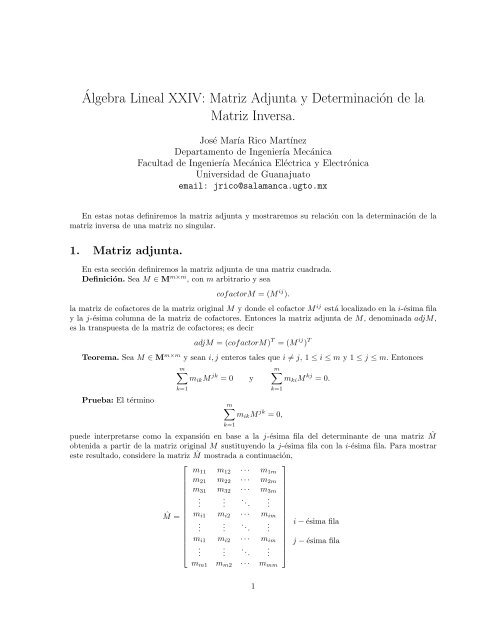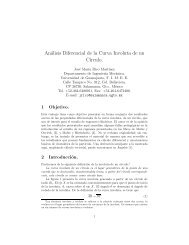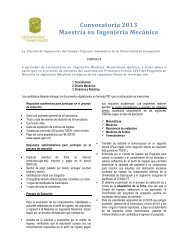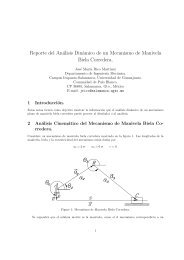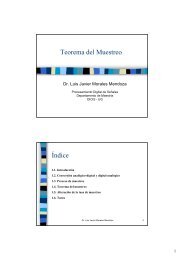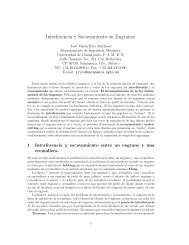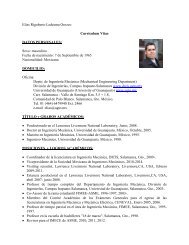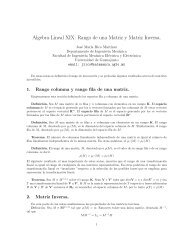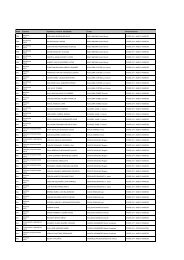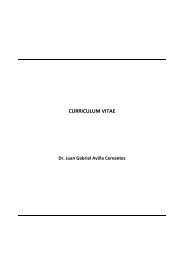Matriz Adjunta y Determinación de la Matriz Inversa.
Matriz Adjunta y Determinación de la Matriz Inversa.
Matriz Adjunta y Determinación de la Matriz Inversa.
You also want an ePaper? Increase the reach of your titles
YUMPU automatically turns print PDFs into web optimized ePapers that Google loves.
Álgebra Lineal XXIV: <strong>Matriz</strong> <strong>Adjunta</strong> y Determinación <strong>de</strong> <strong>la</strong><br />
<strong>Matriz</strong> <strong>Inversa</strong>.<br />
José María Rico Martínez<br />
Departamento <strong>de</strong> Ingeniería Mecánica<br />
Facultad <strong>de</strong> Ingeniería Mecánica Eléctrica y Electrónica<br />
Universidad <strong>de</strong> Guanajuato<br />
email: jrico@sa<strong>la</strong>manca.ugto.mx<br />
En estas notas <strong>de</strong>finiremos <strong>la</strong> matriz adjunta y mostraremos su re<strong>la</strong>ción con <strong>la</strong> <strong>de</strong>terminación <strong>de</strong> <strong>la</strong><br />
matriz inversa <strong>de</strong> una matriz no singu<strong>la</strong>r.<br />
1. <strong>Matriz</strong> adjunta.<br />
En esta sección <strong>de</strong>finiremos <strong>la</strong> matriz adjunta <strong>de</strong> una matriz cuadrada.<br />
Definición. Sea M ∈ M m×m ,conm arbitrario y sea<br />
cofactorM =(M ij ).<br />
<strong>la</strong> matriz <strong>de</strong> cofactores <strong>de</strong> <strong>la</strong> matriz original M y don<strong>de</strong> el cofactor M ij está localizadoen<strong>la</strong>i-ésima fi<strong>la</strong><br />
y<strong>la</strong>j-ésima columna <strong>de</strong> <strong>la</strong> matriz <strong>de</strong> cofactores. Entonces <strong>la</strong> matriz adjunta <strong>de</strong> M, <strong>de</strong>nominada adjM,<br />
es <strong>la</strong> transpuesta <strong>de</strong> <strong>la</strong> matriz <strong>de</strong> cofactores; es <strong>de</strong>cir<br />
adjM =(cofactorM) T =(M ij ) T<br />
Teorema. Sea M ∈ M m×m yseani, j enteros tales que i ≠ j, 1≤ i ≤ m y1≤ j ≤ m. Entonces<br />
m∑<br />
m∑<br />
m ik M jk =0 y m ki M kj =0.<br />
Prueba: El término<br />
k=1<br />
k=1<br />
m∑<br />
m ik M jk =0,<br />
k=1<br />
pue<strong>de</strong> interpretarse como <strong>la</strong> expansión en base a <strong>la</strong> j-ésima fi<strong>la</strong> <strong>de</strong>l <strong>de</strong>terminante <strong>de</strong> una matriz ˆM<br />
obtenida a partir <strong>de</strong> <strong>la</strong> matriz original M sustituyendo <strong>la</strong> j-ésima fi<strong>la</strong> con <strong>la</strong> i-ésima fi<strong>la</strong>. Para mostrar<br />
este resultado, consi<strong>de</strong>re <strong>la</strong> matriz ˆM mostrada a continuación,<br />
⎡<br />
⎤<br />
m 11 m 12 ··· m 1m<br />
m 21 m 22 ··· m 2m<br />
m 31 m 32 ··· m 3m<br />
. .<br />
. . . ..<br />
. .<br />
ˆM =<br />
m i1 m i2 ··· m im<br />
. . . .. i − ésima fi<strong>la</strong><br />
.<br />
m i1 m i2 ··· m im<br />
j − ésima fi<strong>la</strong><br />
⎢ . .<br />
⎣<br />
.<br />
. . ..<br />
. ⎥<br />
. ⎦<br />
m m1 m m2 ··· m mm<br />
1
Note que ˆM jk = M jk .A<strong>de</strong>más, puesto que ˆM tiene dos fi<strong>la</strong>s iguales <strong>de</strong>t ˆM =0,porlotanto<br />
S =<br />
m∑<br />
m ik M jk = <strong>de</strong>t ˆM = <strong>de</strong>t ˆM T =0.<br />
k=1<br />
Un procedimiento semejante permite probar el valor <strong>de</strong> <strong>la</strong> otra sumatoria.<br />
Teorema. Sea M ∈ M m×m .Lainversa<strong>de</strong>M <strong>de</strong>notada por M −1 está dada por<br />
M −1 = adjM<br />
<strong>de</strong>tM<br />
Prueba: Consi<strong>de</strong>re el producto<br />
N = M adjM<br />
<strong>de</strong>tM<br />
Entonces, los elementos <strong>de</strong> <strong>la</strong> matriz N están dados por<br />
1. Elementos en <strong>la</strong> diagonal,<br />
n ii =<br />
n∑<br />
j=1<br />
m ij<br />
M ij<br />
<strong>de</strong>tM = 1<br />
<strong>de</strong>tM<br />
m∑<br />
m ij M ij =1 ∀ 1 ≤ i ≤ m.<br />
j=1<br />
2. Elementos fuera <strong>de</strong> <strong>la</strong> diagonal,<br />
n ij =<br />
n∑<br />
k=1<br />
m ij<br />
M ij<br />
<strong>de</strong>tM = 1<br />
<strong>de</strong>tM<br />
m∑<br />
m ij M ij =0 ∀ 1 ≤ i ≤ m, don<strong>de</strong> i ≠ j.<br />
j=1<br />
De aquí que,<br />
Finalmente<br />
N = M adjM<br />
<strong>de</strong>tM = I m<br />
M −1 = adjM<br />
<strong>de</strong>tM .<br />
2. Problemas Resueltos.<br />
Problema 1. Suponga que <strong>la</strong> matriz M está dadapor<br />
⎡<br />
M = ⎣ 1 3 −1 ⎤<br />
2 −1 3 ⎦<br />
1 2 −3<br />
Determine <strong>la</strong> inversa <strong>de</strong> esta matriz mediante el método<strong>de</strong><strong>la</strong>matrizadjunta.<br />
Solución. De acuerdo con el método, se <strong>de</strong>be obtener primero <strong>la</strong> matriz <strong>de</strong> menores <strong>de</strong> <strong>la</strong> matriz M,<br />
⎡<br />
⎤<br />
−3 −3 5<br />
menorM = ⎣ −7 −4 5 ⎦<br />
8 5 −7<br />
La matriz <strong>de</strong> cofactores <strong>de</strong> M está dadapor<br />
⎡<br />
cofactorM = ⎣ −3 3 5 ⎤<br />
7 −4 −5 ⎦<br />
8 −5 −7<br />
2
Finalmente, <strong>la</strong> matriz inversa <strong>de</strong> M, dada por M −1 ,estádadapor<br />
M −1 = (cofactorM)<br />
| M |<br />
don<strong>de</strong> | M |= 3,porlotanto<br />
⎡<br />
⎣ −3 3 5 ⎤<br />
7 −4 −5 ⎦<br />
M −1 8 −5 −7<br />
=<br />
3<br />
T<br />
⎡<br />
= 1 ⎣ −3 7 8 ⎤<br />
3 −4 −5 ⎦<br />
3<br />
5 −5 −7<br />
3. Problemas Propuestos.<br />
Problema 1. Consi<strong>de</strong>re <strong>la</strong> matriz <strong>de</strong>l problema propuesto 3, <strong>de</strong> <strong>la</strong>s notas Álgebra Lineal XIX:<br />
Rango <strong>de</strong> una <strong>Matriz</strong> y <strong>Matriz</strong> <strong>Inversa</strong>, dada por<br />
⎡<br />
1 −2 2 ⎤<br />
M 1 = ⎣ 3 1 0 ⎦<br />
−1 2 1<br />
Determine su matriz inversa.<br />
3


